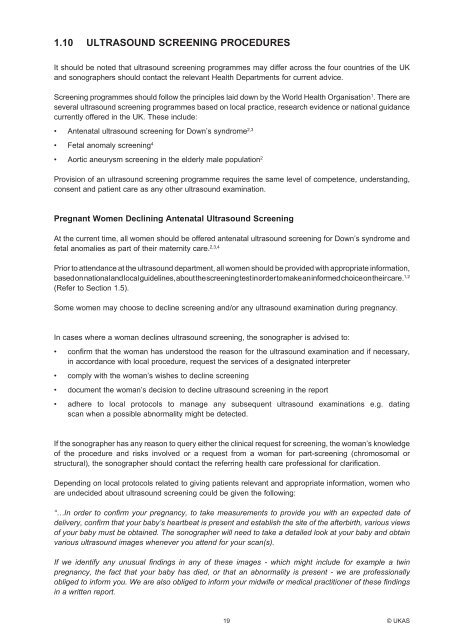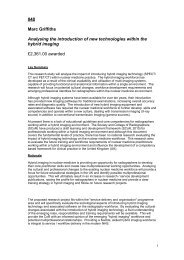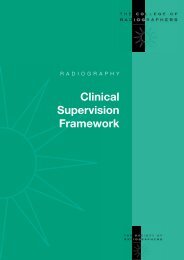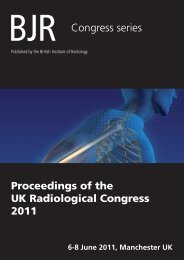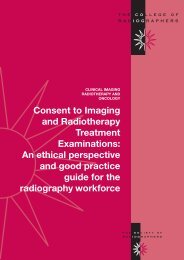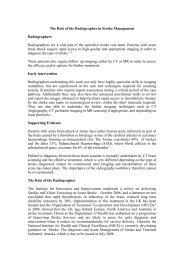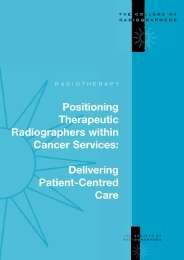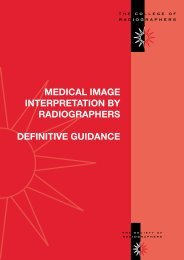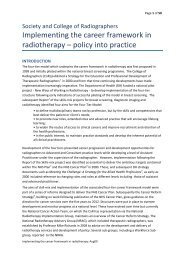Guidelines For Professional Working Standards Ultrasound Practice
Guidelines For Professional Working Standards Ultrasound Practice
Guidelines For Professional Working Standards Ultrasound Practice
You also want an ePaper? Increase the reach of your titles
YUMPU automatically turns print PDFs into web optimized ePapers that Google loves.
1.10 <strong>Ultrasound</strong> Screening Procedures<br />
It should be noted that ultrasound screening programmes may differ across the four countries of the UK<br />
and sonographers should contact the relevant Health Departments for current advice.<br />
Screening programmes should follow the principles laid down by the World Health Organisation 1 . There are<br />
several ultrasound screening programmes based on local practice, research evidence or national guidance<br />
currently offered in the UK. These include:<br />
2,3<br />
• Antenatal ultrasound screening for Down’s syndrome<br />
4<br />
• Fetal anomaly screening<br />
2<br />
• Aortic aneurysm screening in the elderly male population<br />
Provision of an ultrasound screening programme requires the same level of competence, understanding,<br />
consent and patient care as any other ultrasound examination.<br />
Pregnant Women Declining Antenatal <strong>Ultrasound</strong> Screening<br />
At the current time, all women should be offered antenatal ultrasound screening for Down’s syndrome and<br />
fetal anomalies as part of their maternity care. 2,3,4<br />
Prior to attendance at the ultrasound department, all women should be provided with appropriate information,<br />
based on national and local guidelines, about the screening test in order to make an informed choice on their care. 1,2<br />
(Refer to Section 1.5).<br />
Some women may choose to decline screening and/or any ultrasound examination during pregnancy.<br />
In cases where a woman declines ultrasound screening, the sonographer is advised to:<br />
• confirm that the woman has understood the reason for the ultrasound examination and if necessary,<br />
in accordance with local procedure, request the services of a designated interpreter<br />
• comply with the woman’s wishes to decline screening<br />
• document the woman’s decision to decline ultrasound screening in the report<br />
• adhere to local protocols to manage any subsequent ultrasound examinations e.g. dating<br />
scan when a possible abnormality might be detected.<br />
If the sonographer has any reason to query either the clinical request for screening, the woman’s knowledge<br />
of the procedure and risks involved or a request from a woman for part-screening (chromosomal or<br />
structural), the sonographer should contact the referring health care professional for clarification.<br />
Depending on local protocols related to giving patients relevant and appropriate information, women who<br />
are undecided about ultrasound screening could be given the following:<br />
“…In order to confirm your pregnancy, to take measurements to provide you with an expected date of<br />
delivery, confirm that your baby’s heartbeat is present and establish the site of the afterbirth, various views<br />
of your baby must be obtained. The sonographer will need to take a detailed look at your baby and obtain<br />
various ultrasound images whenever you attend for your scan(s).<br />
If we identify any unusual findings in any of these images - which might include for example a twin<br />
pregnancy, the fact that your baby has died, or that an abnormality is present - we are professionally<br />
obliged to inform you. We are also obliged to inform your midwife or medical practitioner of these findings<br />
in a written report.<br />
19 © UKAS


